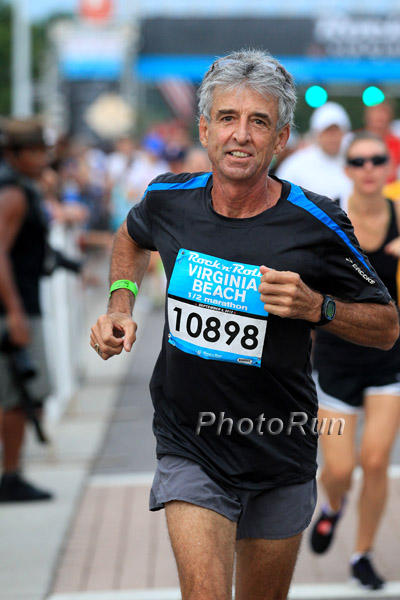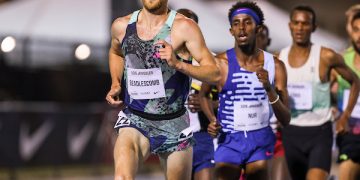 Frank Shorter, VA Beach, 2012, photo by PhotoRun.net
Frank Shorter, VA Beach, 2012, photo by PhotoRun.net
I remember watching Frank Shorter on TV winning the Munich Olympic Marathon. I next, in Sport magazine, read a piece about Frank, written by Neil Admur, I believe.
When I finally met Frank Shorter, after the 1974 AAU Cross Country at Crystal Springs, I was fifteen years old. Frank had just lost his first AAU cross country in five years. He would go on to win the fourth of his Fukuoka marathons a few weeks later. Shorter was quite nice to this group of nerdy fifteen and sixteen year olds. He signed our autograph sheets ( I still have them) and he spoke to us for five or ten minutes. It was the thrill of my young life and I always thanked Frank Shorter for being so kind.
This piece by Jeff Benjamin tells some of the story of the 1976 Olympic marathon, and the challenges Frank Shorter faced, the challenges that shaped him into becoming, along with Steve Prefontaine, the finest American distance runner of his generation.
The 40th Anniversary of Frank Shorter’s Montreal Olympics–by Jeff Benjamin–6/13
Analyze, compartmentalize, and keep setting goals. Even today, these seem to be the ideas and concepts that drive Frank Shorter. In 1976, the American Olympic champion from 4 years earlier in Munich had trained better than ever before and looked to be in fantastic shape to become the second Olympian behind Abebe Bikila to win back to back Olympic Marathons. “I’ve always been pretty much self-coached, so I took care of everything”, Shorter recently said from his home in Boulder, Colorado. “I think it helped me be a little more objective in a different way from the other runners.”
Aside from his physical commitments to over 100 mile per week training for years came the mental approach as well, something which Shorter attained through some of the most horrific and sad events of his childhood. As recently recounted, Shorter dealt with a beyond-abusive father, who physically terrorized the children of the household.
” I had to survive that situation with no system, and I believe it shaped my personality in how I approached my training as well.” It also led him to really treasure his running gifts throughout the decades. “I was able to latch on to running as a means of escaping from my house and dealing with what was going on, and I made it part of my daily routine.”
That fortitude brought Shorter to the heights of the sport, as he excelled in events from the 5000 meters all the way up to the marathon, including in all facets such as Road Racing, Track Racing and Cross-Country. What some may not remember about Shorter from the 1972 Games was that, alongside his Running-Boom Igniting Marathon victory, he had also competed in the 10,000 meters days earlier, finishing in 5th place behind Lasse Viren in an American Record of 27:51.32, a record that broke his previous record which was set in the Qualifying race (27:58.23)!!
In 1976, however, despite once again winning the 10K Olympic Track Trials along with the Marathon, Shorter made his total focus this time on the marathon. But this time, fate seemed to be conspiring against him. Firstly, just prior to the start of the Montreal race, Shorter’s racing shoes which were designed for him had started to crumble apart.
Needing almost immediately another pair of racing shoes, Shorter calmly kept his focus and saw 3 coincidental events occur in his favor. “The first coincidence was seeing the U.S. Racewalking Coach who had the keys to my room in the Olympic Village,” he said. “The second coincidence was that the Olympic Village was really close to the Stadium, and the third coincidence was that I had decided to bring an extra racing pair.”
Ironically, the Racewalking Coach had to have sprinted to Shorter’s Olympic village room and get him those shoes with no time to spare. “Literally within a minute before the start, I finally got to the starting line in the stadium.” But then, as the race progressed (which was led by the furious pace of American teammate Bill Rodgers), the rains came down, which were conditions not in favor for Shorter.
Yet, by mile 20 Shorter had broken up the pack of runners (which included Viren, who would finish 5th in his marathon debut) and except for one runner, was all by himself. Shorter had originally thought the other competitor was Portugal’s Carlos Lopes, who had netted a Silver Medal behind Viren in the 10,000 a few days earlier.
But, unbeknownst to the American it was East Germany’s Waldemar Ciepinski. The East German then began to press the pace and dropped Shorter and went on to win, beating the defending Olympic Champion by 45 seconds, in a time of 2:09:55. Shorter (2:10:30) finished 2nd in a Personal Best, followed by Karol Lismont fro the Bronze. Finishing just 3 seconds behind Lismont, and out of the medals, was American Don Kardong.
Shocked was probably an understatement to describe Shorter’s feelings at the time. He would later say that what shocked him most about Cierpinski was that he knew very little about him. Cierpinksi would later on go on to tie the great Bikila in winning the 1980 boycott-tainted Moscow Olympic Games.
Yet, with end of the Eastern-bloc communist countries in the early 1990’s came the sad truth about the East German government-sponsored doping Programs, of which Ciepinski was a part.
At the time Shorter, Kardong and others had voiced and/or written protests about these athletes and their tainted and unfair performances, which came at the expense of the clean athletes. Yet by the late 1990’s, Shorter decided to once again use his attributes to fight in another way.
” I had decided that my way of dealing with this would be by creating a deterrent. I would treat it not as an individual problem but as a group problem. I viewed Cierpinski as part of the system and that should have been addressed.” Shorter would then go on to lead USADA for a time, and try and concentrate his goal-setting hope in making the competitive field fair for all of the competitors.
As for the argument brought forth by this writer that due to the strict, dictatorial and sometimes brutal rule of the East Germans through their notorious Secret Police known as the Ministry for State Security, but more well-known as the Stasi, athletes like Cierpinksi may have had no choice but to accept the doping, Shorter replied, ” That may be, but, it was also revealed that during his time that while he was an athlete ttraveling with his teams, Cierpinki was also a Stasi informer overseas on his fellow athletes. That made me view him differently.”
These days, Shorter, who just had a successful second back-fusion surgery a few months ago, still runs and cross trains with the same self-analyzing trait that made him the greatest marathoner in the world. He openly talks with people not only about the horror of his abusive childhood, but also carries the mantle in trying to have a clean sport.
Although not wanting to have the title of an official spokesperson for these issues, he nonetheless says, “Look, if my speaking out can help any abused kid or any young athlete who could be affected by these things that have happened to me, and it can lead them in a good way, then that is good.”
Even now, all these years later, Frank Shorter still tries to set noble goals.
NOTE—Frank Shorter’s new Autobiography, “My Marathon: Reflections on a Gold Medal Life” co-written by John Brant along with the foreward by Kenny Moore, is being published by Rodale Press and will be available for sale July 5th, which coincides with U.S. Olympic Track and Field Trials in Eugene, Oregon.
Link to pre-order
Jeff Benjamin has written for 30 years for American Track and Field along with RunBlogRun. The Former President of the Staten Island AC & Chair of the Staten Island Running Association was the 5th man scorer for his Susan Wagner High School NYC XC City Championship team. Also a member of the College of Staten Island Sports Hall of Fame for XC, Jeff currently serves as the LDR Chairman for USATF NY. A passionate (or fanatical) follower of the Sport, some of Jeff's subjects have included Sebastian Coe, Emma Coburn, Eamonn Coghlan, Matt Centrowitz, Jim Spivey, Galen Rupp, Joe Newton, Tom Fleming, Ajee’ Wilson, Bill Rodgers, Allan Webb, Abel Kiviat, Jordan Hassay, Marty Liquori, Caster Semenya, Rod Dixon, Carl Lewis and Jim Ryun as well as Book Reviews and articles covering meets and races in the Northeast U.S.
View all posts
 Frank Shorter, VA Beach, 2012, photo by PhotoRun.net
Frank Shorter, VA Beach, 2012, photo by PhotoRun.net




















